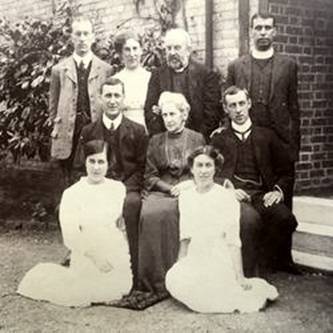
Major
DANIEL KNOX HOPKYNS
Royal Engineers
by
Lieutenant
Colonel Edward De Santis
1. INTRODUCTION
The principal references
used in the preparation of this narrative were from a number of sources.
They include census records, official registries in the United Kingdom,
medal rolls, family trees, Army Lists, and The London Gazette.
All sources are contained in the REFERENCE section at the end of the
narrative and are cited throughout in the ENDNOTES.
Every effort has been made to accurately portray the life and military
service of Major Hopkyns. Since a
good deal of information also was uncovered about members of his family, that
information is presented in this research work following the details of Major
Hopkyns life and service.

Figure 1.
The Hopkyns Family, c. 1915.
(Photograph courtesy of Find a Grave web site).
NOTE: The members of the Hopkyns family are listed in Section 2 below.
Unfortunately the people in the photograph above were not identified in
the Find a Grave web site.
The elderly man and woman in the photograph are surely The Reverend
Thomas Daniel Hopkyns and his wife Mary Dean Hopkyns.
The two women seated on the ground are thought to be (left to right)
Irene Margaret Hopkyns and Ursula Katharine Hopkyns.
The woman standing may be Mary Dean Hopkyns, the eldest of the Hopkyns
daughters. Thomas
and Mary Hopkyns had five sons, but there are only four young men in the
photograph. It
is thought that the Vicar in the photograph is Thomas Gray Hopkyns, as he
resembles very much the known photograph of Thomas shown below.
The other three men are thought to be John Wykeham Hopkyns, William
Stenning Hopkyns and Daniel Knox Hopkins, but it is uncertain which is which.
The date given to the photograph by the author is based on their
appearance and the dates of birth of the sons and daughters.
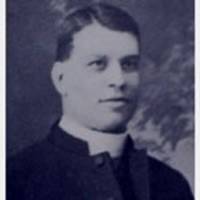
Figure 2.
Thomas Gray Hopkins, c. 1917.
(Photograph courtesy of the Masonic Great War Project)
Daniel Hopkyns came from a very large family of eight children. One of his brothers, Thomas Gray Hopkyns also served in the Great War of 1914-1918 and sadly was killed in action in 1917. His brother John Wykeham Hopkyns served in the Royal Navy from 1900 to 1921 and his brother William Stenning Hopkyns was a member of the Indian Civil Service. Parts of their life stories also are included in this research. Henry Cuthbert Hopkyns was the only brother to follow their father into the church, although Thomas did as well before joining the South African army to fight in the Great War.
Family
Information
Daniel Knox Hopkyns was born in Chichester, Sussex on the 22nd of September 1883, the fifth child of the Reverend Thomas Daniel Hopkyns (1846-1930), the Curate of St. Stephen the Martyr in Marylebone, London and Katharine Mary Hopkyns (née) Stenning (1843-1932). Daniel had four brothers and three sisters: Mary Dean Hopkyns (1876-1970), John Wykeham Hopkyns (1877-1954), William Stenning Hopkyns (1879-1955), Ursula Katharine Hopkyns (1880-1960), Thomas Gray Hopkyns (1882-1917), Henry Cuthbert Hopkyns (1885-1969) and Irene Margaret Hopkyns (1886-1970). The 1881 Census of England shows the Hopkyns family living at 30 South Street in Chichester, Sussex.
1881
Census of England
|
Census
Place: Chichester, Sussex. |
|||||
|
Name
and Surname of each Person |
Relation |
Marital
Status |
Age |
Profession
or Occupation |
Birthplace |
|
Thomas
D. Hopkyns |
Head |
Married |
32 |
Rector
of All Saints & St. Andrews |
Middlesex,
London |
|
Katharine
M. Hopkins |
Wife |
Married |
38 |
|
Sussex,
East Grinstead |
|
Mary
D. Hopkyns |
Daughter |
|
4 |
|
Hants,
Southsea |
|
John
W. Hopkyns |
Son |
|
3 |
|
Hants,
Southsea |
|
William
S. Hopkyns |
Son |
|
2 |
|
Hants,
Southsea |
|
Ursula
K. Hopkyns |
Daughter |
|
5
mos |
|
Sussex,
|
|
Mary
A. Wilkins |
Servant |
single |
22 |
Nurse
(domestic) |
Hants, |
|
Amy
Poulter |
Servant |
single |
21 |
General
servant |
Surrey,
Walton-on-Thames |
|
Mary
E. Millyerd |
Servant |
single |
15 |
Nurse
girl |
Sussex,
Binstead |
Today the building where the Hopkyns resided is a three story brick and stucco structure located in a very busy commercial district on South Street in Chichester. From the age of the upper two stories shown in the photograph below, it is quite possible that this building existed in 1881. Obviously the “Game” store at ground level has ruined its historic value. The building does not appear to be big enough to house such a large family, but its looks may be deceptive as it may be a very deep structure.
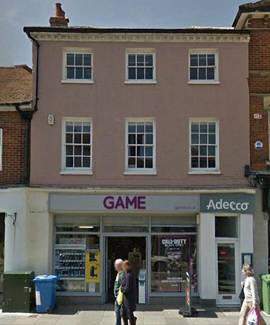
Figure 3. 30 South Street,
Chichester, West Sussex, c. 2019.
(Image courtesy of Google Earth)
During the next ten years the Hopkyns family was to get much larger. The four children shown in the 1881 census increased to eight with the addition of Thomas, Daniel, Henry and Irene. Ursula, who would have been about 10 years old in 1891, does not appear in the census and her whereabouts at this time is unknown. The 1891 Census of England shows the Hopkyns family living at 20 Winchester Road in Hampstead, London.
1891
Census of England (RG12/108)
|
Census
Place: Hampstead, County of
London |
|||||
|
Name
and Surname of each Person |
Relation |
Marital
Status |
Age |
Profession
or Occupation |
Birthplace |
|
Thomas
D. Hopkins [sic] |
Head |
Married |
42 |
Clerk
of Holy Order |
London, |
|
Katharine
M. Hopkins |
Wife |
Married |
48 |
|
Sussex,
Chichester |
|
Mary
D. Hopkyns |
Daughter |
Single |
14 |
Scholar |
Hampshire,
Southsea |
|
John
W. Hopkyns |
Son |
Single |
13 |
Scholar |
Hampshire,
Southsea |
|
William
S. Hopkyns |
Son |
Single |
12 |
Scholar |
Hampshire,
Southsea |
|
Thomas
G. Hopkyns |
Son |
Single |
8 |
Scholar |
Sussex,
Chichester |
|
Daniel
K. Hopkyns |
Son |
Single |
7 |
Scholar |
Sussex,
Chichester |
|
Henry
C. Hopkyns |
Son |
Single |
5 |
|
Sussex,
Chichester |
|
Irene
M. Hopkyns |
Daughter |
Single |
4 |
|
Sussex,
Chichester |
|
Ellen
Oliver |
Servant |
Single |
20 |
Nursemaid |
Sussex,
Singleton |
|
Alice
L. Pugh |
Servant |
Single |
21 |
Cook |
London |
|
Rosa
M. Easton |
Servant |
Single |
21 |
Housemaid |
Sussex,
Hastings |
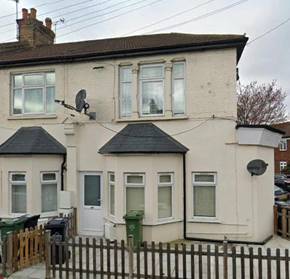
Figure 4. 20 Winchester
Road, Hampstead London, c. 2019.
(Image courtesy of Google Earth)
The Reverend Thomas Daniel Hopkyns appears to have done quite well financially. He was able to raise eight children and employ three household servants from as far back as at least 1881. Additionally, three of his sons would attend a prestigious public school and then Oxford University. It is hard to imagine that his wealth came from his ecclesiastical work alone. His father, Thomas Hopkyns, was a Wholesale Druggist and his father-in-law, William Stenning, was a Timber Merchant. Could the Reverend Hopkyns wealth have come by way of inheritance from one or both of these gentlemen?
By 1911 Daniel had left his family home. The 1911 Census of England and Wales shows him living as a Boarder, age 27, unmarried and working as an Assistant Surveyor, Class II at a post office in Budleigh, Salterton, Devonshire.
The Educations of the Brothers
Daniel entered Merchant Taylor’s School in 1894 and was awarded a School Tercentenary Scholarship. He also was the winner of a Pitt Exhibition. He was a Head Monitor at the school in 1901 and 1902. His brother Thomas also entered Merchant Taylor’s School in 1894 and his brother Henry entered the school in 1895.[ii]
Thomas left Merchant Taylor’s School in 1900 with an Exhibition from Exeter College, Oxford University.[iii] Henry left Merchant Taylor’s School in 1901 and matriculated at Keble College, Oxford while Thomas matriculated at Brasenose College, Oxford in the same year.
Daniel left Merchant Taylor’s in 1902 and on the 28th of October of that year he matriculated at Pembroke College, Oxford University, having received an Open Classical Scholarship.[iv]
In 1904 Thomas received a Bachelor of Arts Degree from Brasenose College and entered Wells Theological College.[v]
Daniel was appointed to the Civil Service on the 4th of November 1907 after receiving a Bachelor of Arts degree from Pembroke College. He took a position as an Assistant Surveyor (Class II) in the General Post Office.[vi] Presumably his position was located somewhere in Oxfordshire, as his resident address was Long Wittenham Vicarage, Abingdon, Oxfordshire. In 1907 his brother Thomas was the Curate of St. Johns Baptist Church in Leamington, Warwickshire, an appointment that he received after completing his studies at the theological college. Thomas resided at 73 Brunswick Street in Leamington at this time.[vii] In 1909 Daniel received a Master of Arts degree from Pembroke College and his brother Thomas received the same degree from Brasenose. Daniel continued working in the post office in Devonshire until 1914 when he was commissioned in the Royal Engineers. On the 2nd of October 1913 he was granted the Freedom of the City of London. All of the Hopkyns brothers were granted this same honor and received identical certificates.
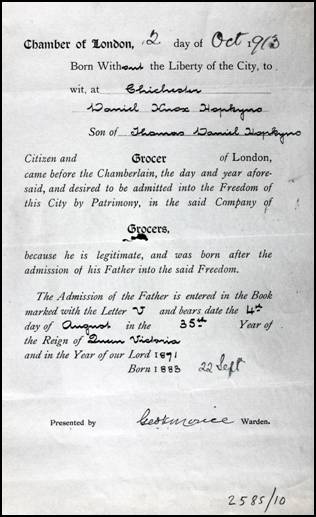
Figure 5. Freedom of the
City of London.
(Image from the keleluka family tree)
3.
PHYSICAL DESCRIPTION
Since the service papers (WO 339 and/or WO 374)[viii] of Daniel Knox Hopkyns were not found during the course of this research, no reasonable physical description of him is available. His service papers would include his height and weight and the color of his eyes and hair, as well as his complexion and chest measurements at the time that he entered the Army. These papers also would provide health information during his time in service. Since it appears that he left the Army in 1920, his date of relinquishing his commission or the date that he was demobilized falls in that limbo period during which records were either kept at the Public Records Office (now the National Archives) or were sent to the Army Personnel Centre in Glasgow. What is further confusing is that Hopkyns served in the Supplementary Reserve of Officers until at least 1926 and he may even have received an Emergency Commission during World War 2. Given these two facts, it is difficult to say where his records may now reside.
4. COMMISSIONING AND
TRAINING
Daniel Knox Hopkyns was commissioned a Temporary 2nd Lieutenant in the Royal Engineers on the 24th of November 1914 and was posted to the Royal Engineers Postal Service.[ix] At this time in history, and for many years later, the Royal Engineers were responsible for military postal services. Hopkyns’ civil service as an Assistant Surveyor with the General Post Office would have made him eminently qualified to serve in the Royal Engineers in this capacity. He probably was considered to be already “trained” based on his post office experience, and since this type of work would be what he would perform while in the Army, he was not required to attend officer training at the School of Military Engineering (S.M.E.) at Chatham, Kent. In essence, except for knowing how to wear his uniform, the basics of military courtesy (knowing who to salute) and the particulars and peculiarities of the military postal system, he almost was ready to perform his postal duties from his first day on duty.
5.
ASSIGNMENTS AND CAMPAIGN SERVICE
Egypt
(1915)
Temporary 2nd Lieutenant Hopkyns, Royal Engineers Postal Section Special Reserve was graded as a Staff Captain on the 22nd of February 1915 for purpose of being assigned as an Assistant Director of Postal Services in a command abroad.[x] It was not unusual in the early days of the Great War to assign new 2nd Lieutenants to these duties as Staff Captains, as there was a shortage of experienced officers in the R.E. Postal Service.[xi]
On the 24th of February 1915 Hopkyns sailed aboard S.S. Dunluce Castle bound for Egypt. He was placed in charge of “Z” Party aboard the ship and he improvised a Base Post Office on board. After a stop in Lemnos, Greece for 14 days he reached Alexandria on the 27th of March and opened a post office at the docks shortly afterwards as part of the Egyptian Expeditionary Force (E.E.F.).[xii] British Army Post Office (BAPO) Y existed at the time in Lemnos to support the Gallipoli Expedition; however, Hopkyns was not assigned to this BAPO except perhaps for the 14 days that he spent in Lemnos. When he arrived in Egypt, only BAPO Z existed in Alexandria.[xiii]
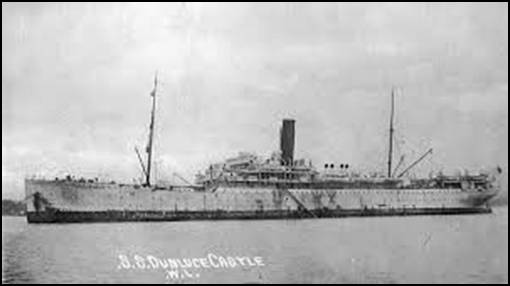
Figure 6. S.S. Dunluce
Castle.
(Photograph courtesy of Passengers in History web site)
Salonika
(1915-1916)
Hopkyns was posted to Salonika in October of 1915. The following month a Base Post Office (BAPO X) was opened in Salonika and it remained open until September of 1919. Hopkyns would serve there for less than a year, but he would return to Salonika again shortly after the end of the war. A detailed history of the R.E. Postal Service work in Salonika may be found in Chris Grimshaw’s work, The Salonika Campaign – A Postal History 1915-1918.
Hopkins was appointed a Temporary Captain on the 26th of June 1915 and was posted to the British Expeditionary Force (B.E.F.) in France sometime in 1916.
France (1916-1918)
It was not unexpected that Hopkyns would be posted to France, the major theatre of the Great War, as the number of British forces serving in Salonika was small compared to the number on the Western Front that required postal services. A large Base Army Post was located at Boulogne (BAPO 3). Other post offices opened at the time of his arrival included BAPO 1 at Le Havre and BAPO 4 at Calais. BAPO 2 was located at Rouen, but this post office became a Canadian BAPO after July of 1915.
On the 1st of September 1916 he was appointed to the rank of Temporary Captain. On the 27th of September 1917 “Temporary Captain Hopkyns, Special Reserve of Officers, Royal Engineers Postal Section was appointed Acting Captain (without the pay or allowances of that rank) whilst holding the appointment of Deputy Assistant Director of Postal Services.”[xiv] When one reads this announcement in the London Gazette one marvels at the workings of the British Army at that time. Here the man is given considerably more responsibility (Deputy Assistant Director) but he does not receive any additional pay or allowances while serving in this position. Basically he gets to wear three pips on his epaulettes, but he already had been appointed a Temporary Captain (1 September 1916), so one wonders what advantage this appointment held for Hopkyns. It is possible that after his appointment to Temporary Captain on the 1st of September, he may have reverted to the rank of Temporary Lieutenant. His performance of duty in this new position obviously was exemplary, as he was mentioned in the despatches of Sir Douglas Haig dated 14 December 1917 for his service in France.
Italy
(1918-1919)
Hopkyns was posted to Italy sometime in 1918 where a Base Army Post Office was located at Arquata (BAPO S101/L1) to support the Italian Expeditionary Force. This post office had opened in November of 1917 and it remained open until March of 1920.[xv]
On the 4th of February 1918 Hopkyns relinquished the acting rank of Captain and reverted to the rank of Temporary Lieutenant. However, in the mystical way in which the British Army operated at that time, on the 21st of February he was appointed an Acting Major with the pay and allowances of a Captain.[xvi] For some strange reason, a pecuniary reason no doubt, his pay and his rank could never seem to coincide. He was again Mentioned in Despatches for his service in Italy.[xvii]
While in Italy Hopkyns purchased as piece of art which he shared with the author of a book entitled Our Italian Front, the cover of which is shown below.
|
Figure 8. Book Cover of Our Italian Front. |
Figure
7. Partial List of
Illustrations of Our Italian Front. |
|
Figures 7 & 8. The
Cover of Our Italian Front, the
List of Illustrations showing Hopkyns Name Associated with the Ponte S.
Michele, Vicenza Painting and the Painting with Description.
|
|
|
Figure
9. The Painting from Our
Italian Front. |
|
|
Figure
10. Description of the
Painting from Our Italian Front. |
|
The List of Illustrations shows that Major Hopkyns was the owner of the original painting. The caption associated with the painting would seem to indicate that Hopkyns was serving in the vicinity of Vicenza during his time in Italy in 1918 or 1919. This was an interesting discovery inadvertently uncovered during the research into Hopkyns military service.
Salonika
(1919)
BAPO X was still open in 1919 when Hopkyns arrived there. In fact it remained open until September of 1919. On the 5th of June 1919 Hopkyns was again Mentioned in Despatches for his service in Salonika.[xviii] On the 22nd of June 1919 he relinquished the rank of Acting Major and reverted to the rank of Temporary Lieutenant.[xix] This was likely due to the Salonika Force preparing to leave Greece following the Armistice. Hopkyns appears to have returned home from Greece early in 1920.
On the 23rd of January 1920, while serving with the Surveyors Department at the General Post Office, Western District in Edinburgh, Scotland, Hopkins applied for his oak leaf emblem to place on his Victory Medal in recognition of his mentions in despatches.[xx] He traveled on the continent for some time from March to August of 1920. He had relinquished his commission and had been demobilized from the Army in May. By the 30th of August 1920 he was residing at 59 Manor Place in Edinburgh. He only lived there a short time before moving to an address on Ainslie Place in Edinburgh.
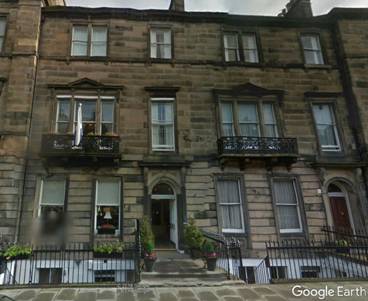
Figure 11. 59 Manor Place,
Edinburgh, Scotland.
(Image courtesy of Google Earth)
__________________________________________________________________________
The
following sections are presented in tabular form to summarize Jenkins’
promotions, appointments, military training and qualifications and the medals
that he was awarded during his time in the Army.
They are provided to give the reader easy access to these aspects of his
military career. The tables are
followed by sections dealing with his marriage, personal information and
post-service life.
_________________________________________________________________________
6.
PROMOTIONS AND APPOINTMENTS
a. Promotions: Hopkyns received the following promotions during his time in service:
Date of Promotion or Appointment |
Rank
or Position |
|
24 November 1914 |
Commissioned Temporary 2nd Lieutenant, Royal Engineers Special Reserve. |
|
26 June 1915 |
Appointed Temporary Lieutenant. |
|
1 September 1916 |
Appointed Temporary Captain. |
|
27 September 1917 |
Appointed Acting Captain (without the pay and allowances of that rank. |
|
4 February 1918 |
Relinquished rank of Acting Captain, reverts to Temporary Lieutenant. |
|
21 February 1918 |
Appointed Acting Major (with pay and allowances as a Captain). |
|
22 June 1919 |
Relinquishes rank of Acting Major, reverts to Temporary Lieutenant. |
|
May 1920 |
Relinquishes commission as a Temporary Lieutenant. |
|
7 May 1923 |
Appointed Major, Royal Engineers Special Reserve. |
|
3 July 1926 |
Appointed Major from the Regular Army Reserve of Officers. |
|
1932 |
Serving as Major, Royal Engineers, Territorial Army and Supplementary Reserve. |
|
22 September 1933 |
Having reached the age limit, ceases to belong to the Reserve of Officers. |
Date of Appointment |
Position |
|
22 February 1915 |
Assistant Director of Army Postal Services (Egypt). |
|
24 February 1915 |
Officer-in-Charge of “Z” Party, Royal Engineers post office aboard S.S. Dunluce Castle. |
|
27 September 1917 |
Deputy Assistant Director of Postal Services (France). |
As previously indicated, Hopkyns received very little if any military training before assuming his duties with the Royal Engineers Postal Service.
8. MEDALS, AWARDS AND
DECORATIONS
Major Hopkyns received the following medals, awards and decorations during his time in service:[xxi]
|
Date |
Medal
or Award |
|
28 June 1921 |
1914-15 Star |
|
28 June 1921 |
British War Medal |
|
28 June 1921 |
Victory Medal (3 times mentioned in despatches) |
|
6 May 1935 |
King George V Silver Jubilee Medal |
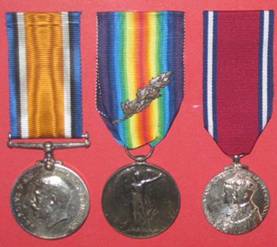
Figure 12. The Medals of
Daniel Knox Hopkyns.
(Photograph from the author’s collection)[xxii]
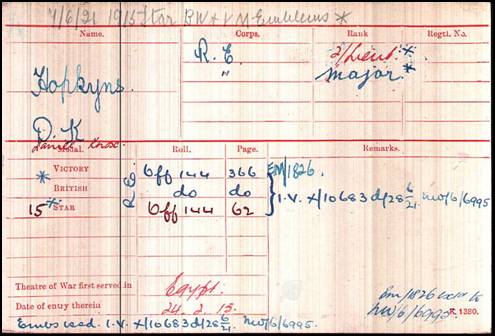
Figure 13. The Medal Index
Card of Major Daniel Knox Hopkyns (front).
(Image courtesy of Ancestry.com)
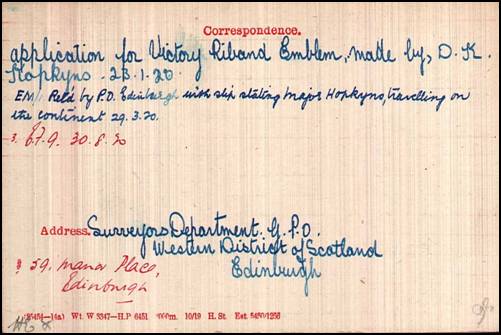
Figure 14. The Medal Index
Card of Major Daniel Knox Hopkyns (back).
(Image courtesy of Ancestry.com)
9.
ADDITIONAL FAMILY INFORMATION
PARENTS
Thomas
Daniel Hopkyns (1846-1930)
Thomas Daniel Hopkyns was born in Paddington, London in 1846. He received a Bachelor or Arts degree from Pembroke College, Oxford in 1872 and a Master of Arts degree from the same college in 1874. He was the curate of East Grinstead, Sussex from 1872 to 1875 and for St. Jude’s Church in Southsea, Hampshire from 1875 to 1879. From 1879 to 1890 he was the rector of St. Andrews and All Saints Church in Chichester, Sussex and in 1890 he was appointed the curate of St. Stephen the Martyr in the Boroughs of Hampstead and St. Marylebone in the Church of England Diocese of London.[xxiii]
Thomas married Katharine Mary Stenning in East Grinstead, Sussex in July of 1875 while he was the curate there. The Hopkyns did quite a bit of moving during Thomas’ time in Holy Orders and various references[xxiv] show them living at the following addresses:
· 1885 – 1889: Freehold Farm, South Street, Chichester, Sussex
· 1890 - 1891: 1 Norfolk Terrace, East Sheen, Mortlake, London
· 1892 – 1898: 20 Winchester Road, South Hampstead, London
· 1899 – 1903: 139 King Henry’s Road, Hampstead, London
· 1905 – 1925: The Vicarage, Wittenham, Berkshire
Hopkyns owned in excess of 97 acres in the village of Wittenham. Owning this much land reinforces the assumption made previously that the Hopkyns family was well-off financially. Although no references could be found to indicate where he and his wife may have lived after 1925, it may be assumed that they spent a good number of years in or near Wittenham. Thomas Daniel Hopkyns died on the 6th of October 1930 at 26 Warnborough Road in Oxford. His place of death therefore provides some indications of their residence in their final years.
The 1931 Probate Calendar entry for Hopkyns death reads as follows:
“HOPKYNS the reverend Thomas Daniel of 29 Warnborough-road Oxford clerk died 6 October 1930 Probate (save and except settled land) Oxford 3 January to John Wykeham Hopkyns engineer commander R.N. and Daniel Knox Hopkyns H.M. army. Effects £11,131 0s 1d.” This amount would equate to about $1,325,600 US in 2019 currency.
The 1932 Probate Calendar entry for Hopkyns death reads as follows:
“HOPKYNS the reverend Thomas Daniel of 26 Warnborough-road Oxford clerk died 6 October 1930 Administration (with Will) (limited to settled land) Oxford 11 March to John Wykeham Hopkyns engineer commander R.N. and Daniel Knox Hopkyns major H.M. Army, effects £3,983. Former Grant D.R. Oxford 3 January 1931.”
The author is uncertain regarding the terminology, but it appears that Thomas had made a change to his will of 3 January 1931 so that the “(save and except settled land)” in the will probated in 1931 was changed to “(with Will) (limited to settled land) in the will probated in 1932 and the effects were changed from £11,131 to £3,983, this latter amount being only about $510,400 US in 2019 currency. In both cases his heirs were John and Daniel, favoring his sons who had served in His Majesty’s forces. This may be due to the fact that his only remaining son, William Stenning Hopkyns, had done very well on his own financially.
Katharine
Mary Hopkyns (1843-1932)
Katharine Mary Hopkyns (née Stenning) was born in 1843 in East Grinstead, Sussex, the daughter of William and Mary C. Stenning. The 1871 Census shows that her father and two of her brothers were timber merchants and one brother was an East India merchant. She had four brothers and one sister and she was the second oldest child in the family. Her mother and father had five servants in 1871 and obviously were well-off financially. Katharine was living with her parents in 1871 and met and married Thomas Daniel Hopkyns when he was the curate of East Grinstead between 1872 and 1875.
Katharine died on the 29th of June 1932 while living at the 26 Warnborough Road address in Oxford. Her will was probated in Oxford on the 22nd of September 1932, leaving £1,009 3s. 8d. to be shared by her sons John and Daniel. Her effects amounted to about $129,300 US in 2019 currency.
BROTHERS
AND SISTERS
Mary
Dean Hopkyns (1876-1970)
Mary Dean Hopkyns was born on the 27th of May 1876 at Southsea, Hampshire. It appears that she remained single all her life. She died at New House, Forest Hill, Oxford on 4th of January 1970. Her will was probated at Oxford on the 4th of March 1970 with her effects totaling £14,830 (about $308,300 US in 2019 currency). No additional information could be found regarding her life. Mary was the first born of all the Hopkyns children and she outlived most of them.
John
Wykeham Hopkyns (1877-1954)
John Wykeham Hopkins was born on the 18th of September 1877 at Southsea, Hampshire. He entered Westminster School on the 25th of September 1890 and left in December of 1894. He was commissioned a Probationary Assistant Engineer in the Royal Navy on the 1st of July 1899. John served in the Royal Navy as an engineering officer from 1900 until 1921. During that time he received the following promotions:
Assistant Engineer: 1 July 1900
Engineer Lieutenant: 1 June 1904
Engineer Lieutenant Commander: 1 June 1912
Engineer Commander: 1 October 1917
In 1907, as an Engineer Lieutenant, he served in the Mediterranean aboard HMS Venus, an Eclipse-class second-class protected cruiser built for the Royal Navy in the mid-1890s. He served in the English Channel and the North Sea during 1914 to 1917 and with the North Atlantic convoys from 1917 to 1918. He was present at the Battle of Jutland. From 1916 to 1920 he served as an Engineer Lieutenant Commander aboard HMS Ossory and HMS Erin and was awarded the 1914-15 Star, British War Medal and Victory Medal for his service during the Great War. He retired from the Royal Navy on the 24th of November 1922 as an Engineer Commander. John married Maud Annie Louise Creasey,
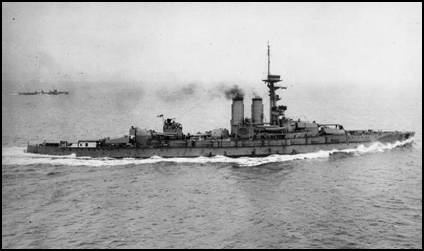
Figure 15. HMS Erin.
(Photograph courtesy of Wikipedia)
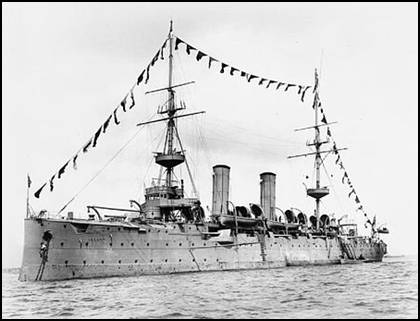
Figure 16. HMS Venus.
(Photograph courtesy of Wikipedia)
On the 16th of November 1898 John was granted the Freedom of the City of London and was awarded a certificate attesting to the same. He married Maud Annie Louise Creasey, the youngest daughter of Charles Albert Creasey of Hill House, Walton Suffolk, on the 12th of June 1909. The marriage took place in Woodbridge, Suffolk. Apparently John and Maud did not have any children.
John was a Mason and he was a member of many lodges during his life. The following is a list of the lodges along with their locations and his initiation date:
· Royal Naval Lodge, Malta: 23 March 1907
· Waller Rodwell Wright Lodge, Malta: 23 March 1907
· Adams Lodge, Sheerness, Kent: 2 June 1908
· Philammon Lodge, Devonport, Plymouth: 11 March 1920
· Phoenix Lodge, Stowmarket, Suffolk: 18 February 1921
John Wykeham Hopkyns died on the 24th of April 1954, age 76, at Gipping, Suffolk. He is buried in St. Peters Churchyard in Tewin, Hertfordshire. The 1954 Probate Calendar lists him as “otherwise John of Meadland Combs, Stowmarket, Suffolk.” His will was probated at Ipswich on the 25th of August 1954 with his effects going to his widow, Maud Annie Louise Hopkyns and his solicitor John Philip Manning Prentice in the amount of £21,378 2s. 5d. (about $1,278,500 US in 2019 currency).
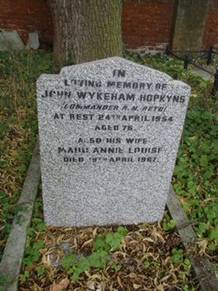
Figure 17. The Gravestone of
John Wykeham and Maud Annie Louise Hopkyns.
(Photograph courtesy of Find a Grave)
William
Stenning Hopkyns (1879-1955)
William Stenning Hopkyns was born on the 3rd of February 1879 at Landport, Southampton. He was educated at Westminster School and Christ Church College, Oxford. He was appointed to the Indian Civil Service in 1902 after examination and he arrived in India to take up his post on the 27th of November 1903.
Hopkyns served in Bengal as an Assistant Magistrate and Collector[xxv] and as a Joint Magistrate and Deputy Collector[xxvi] until October of 1910. In November of 1914 he was appointed as a Superintending Magistrate and Collector. He was confirmed in this position in April of 1917. He was made an Officer of the Order of the British Empire (O.B.E.) in January of 1919 while he was stationed in Mymensingh, Bengal.[xxvii]
From December of 1920 to April of 1922 Hopkyns served as the Officiating Secretary to the government of Bengal revenue department and then again in this position from April 1924. He was confirmed as the Secretary of the revenue department in March of 1925 and was made a Companion of the Order of the Indian Empire (C.I.E.) in June of 1928 when he also was appointed to the position of Officiating Chief Secretary to the government of Bengal. He was confirmed in this position in May of 1930. In June of 1932 he was appointed the Commissioner of Bengal and he retired in June of 1933.[xxviii]
In 1920 he apparently took home leave from Bengal. The ship’s manifest for the Korea Maru shows him arriving at San Francisco, California on the 12th of August 1920 from Yokohama, Japan with his final destination as Long Wittenham, England.
William apparently made his retirement home in Tewin, Hertfordshire.
At the time of his death on the 31st of May 1955 his residence
was Tewin Orchard, Tewin Hertfordshire, although he died in Napsbury Hospital in
St. Albans, Hertfordshire. His will
was probated at Peterborough on the 11th of August 1955 with his
effects in the amount of £27,137 15s. 6d. (about $935,200 US in 2019 currency)
going to Barclays Bank Limited.
Ursula Katharine Hopkyns
(1880-1960)
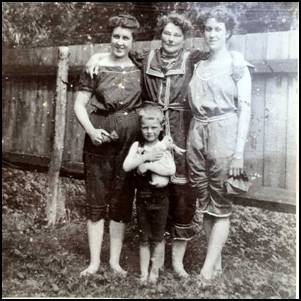
Figure 18. Ursula Katharine Hopkyns (right), circa 1900.
(Photograph courtesy of Jenny Hodgson)
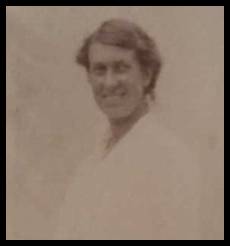
Figure 19. Ursula Katharine
Hopkyns in Later Years.
(Photograph courtesy of Jenny Hodgson)
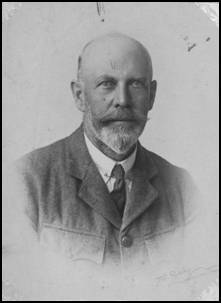
Figure
20. John Spencer Ward, Husband of
Ursula Katharine Hopkyns.
(Photograph courtesy of the Gibbs Family Tree)
Thomas Gray Spencer Ward attended the Nautical College at Pangbourne,
Berkshire, from 1942 to 1946. He then joined the Port Line as an apprentice and
remained with the company until his retirement in 1980. The Port Line was a
subsidiary of the Liverpool-based Cunard Line. For about twenty years Ward
commanded Port Line vessels, mostly trading with Australia and New Zealand.
Ward had a strong interest in postal history and philately and built up
considerable knowledge of the sailing ships and steamers that carried mails
between Britain and Australia and New Zealand in the nineteenth century. In the
1960s he contributed regular articles on this subject to the Postal History
Society Bulletin. He assembled a large collection of Australian letters on
account of their postmarks, including both business and personal letters. Some
were written by notable figures such as William Westgarth, Sir Alfred Stephen,
the Reverend Thomas Stowe and Fanny Bussell. Recognizing that the contents of
the letters, as well as their covers, were important, Ward offered them for
copying to the Australian Joint Copying Project on a number of occasions between
1960 and 1967.
After
he retired, Ward emigrated to Australia and lived at Nambucca Heads on the north
coast of New South Wales. He maintained his interest in postal history and in
2000 published The California, New Zealand and Australian Mail Line of steam
packets 1870-71.
Ursula died on the 4th of August 1960 at Lammas Eyot, Long Wittenham, Berkshire. Her will left her effects of £8,625 73s. 6d. (about $264,310 US in 2019 currency) to her son Thomas and to her daughter Ursula Mary Ward, a spinster.
Ursula Mary Ward died on the 28th of June 2016 at Lammas Cottage, High Street, Long Wittenham, Abingdon, Oxfordshire.
Thomas Gray Spencer Ward died on the 14th of November 2019 at Nambucca
Heads, New South Wales, Australia. His
death occurred as this narrative was being written.
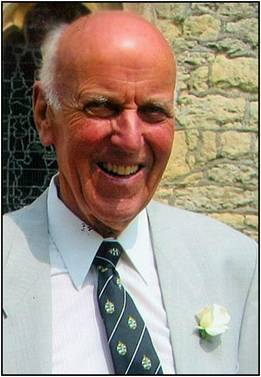
Figure
21. Thomas (“Tom”) Gray Spencer
Ward.
(Photograph courtesy of Bernard Laverty Funerals)
Thomas
Gray Hopkyns (1882-1917)
Prior to the Great War of 1914-1918, Thomas was a Chaplain to
the South African Church Railway Mission. His
name appears in Light for the Line, the
mission magazine between 1911 and 1913. The
magazine shows that in 1911 Reverend T.G. Hopkyns, M.A. was performing mission
work in Waterval Boven, a small town situated on the banks of
the Elands River above the Elands Falls on the railway line from Pretoria to
Maputo. In January of 1912 he was in
Auckland Park, Johannesburg, the headquarters of the Diocese of Pretoria and in
October of 1912 he was in The Rectory at Germiston, a town in the Witwatersrand
directly southeast of Johannesburg. His
name appears for the last time in the mission magazine in April of 1913, showing
that he still was at Germiston. In
1914 Thomas was the Vicar of Randfontein in South Africa when the Great War
broke out.
According to the Oxford Roll of Service Thomas enlisted in the South
African Medical Corps on the 19th of April 1917 and rose to the rank
of Sergeant. Thomas was killed in
action at Menin Road on the 20th of September 1917.
In the photograph below (Figure 23.) his cap badge is that of the 1st
South African Infantry Regiment (Figure 22) and he appears to be Private.
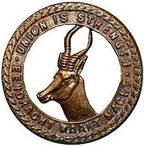
Figure
22. Cap Badge of the 1st
Regiment, South African Infantry.
(Image courtesy of Wikipedia)
The Reading (Berkshire) Mercury dated 6 October 1917 provided this notice
of his death:
“The Rev. Thomas Gray Hopkyns, Vicar of Randfontein,
Transvaal, a private in the South African Medical Corps, was killed on September
20th while on stretcher duty near the firing line, aged 35, the third
son the Rev. T. Daniel and Mrs. Hopkins of Long Wittenham Vicarage, Berks.
He was educated at Brasenose College, Oxford, and was ordained in 1915 [sic][xxix] to the curacy of St. John the Baptist, Leamington, where he remained
until 1910, when he was appointed Bishop’s assistant chaplain to the Railway
Mission at Pretoria. In 1914 he was
appointed to the vicarage of Randfontein.”
This information generally agrees with that found in copies of Light for the Line but it is disputed by the an Imperial War Museum
Memorial to Thomas and the Commonwealth War Graves Commission (CWGC), both of
which indicate that he was 14724 Private Thomas Gray Hopkyns, 1st
South African Infantry Regiment. The
CWGC does indicate that he had been Chaplain to the South African Church Railway
Mission.
Except for the notice printed in The
Mercury, there is no indication that he had ever been in the South African
Medical Corps or that he had risen to the rank of Sergeant. The Masonic Great
War Project memorial for him also indicates (unverified) that he served in the
South African War of 1899-1902.
Craig and Gibson indicate that Thomas Gray Hopkyns was serving as the
Chaplain for the 1st Regiment, South African Infantry.
This may be an error. Someone
may have confused his civil occupation as a vicar with his military duties
during the war. However, to add to
the confusion, the Imperial War Museum War Memorials Register lists Thomas Gray
Hopkyns as Chaplain, South African Infantry – 1st Regiment.
He is buried at the White House Cemetery, St. Jean-Les-Ypres.
It is difficult to rationalize how a man could be a Private in an
infantry regiment and at the same time be a Private in the medical corps
(stretcher bearer) and could have risen to the rank of Sergeant (after being
killed) and at the same time have been a Chaplain, which surely would have made
him something other than a Private. The
issue is too confused and probably will never be sorted within the confines of
this research project.
Hopkyns regiment formed part of the 1st South African Infantry
Brigade. The 1st South African
Infantry Regiment was commanded by Lt Col F.S. Dawson with the regiment being
raised from the Cape Province and known as "The Cape Regiment."
“A” Company (Western Province) was made up from men mostly from the Duke of
Edinburgh's Rifles. “B” Company was recruited from the Eastern Province and
“C” Company was from Kimberley, with many of the men being ex-Kimberley
Regiment. “D” Company was recruited from Cape Town.
During the Great War the regiment took part in the following major
actions up until the time of Hopkyns death at Menin Road:
Since Hopkyns enlisted in April of 1917 he would not have taken part in the battle in Egypt nor in the battles on the Somme or at Le Transloy or the Scarpe. The Third Battle of Ypres, or Passchendaele, started on the 31st of July 1917, so it is conceivable that he was present for that action. The first day of the Battle of Menin Road was the 20th of September 1917, the day that he was killed. During this battle the British 9th and 55th Divisions of V Corps were to attack on fronts of 1,800 yards over ground held by the right of the German 121st Division and the 2nd Guards Reserve Division, which had also changed hands twice in August. The large numbers of strong points, pillboxes and fortified farms east of the Hanebeek and Steenbeek streams were mostly intact, despite numerous attempts to smash them with artillery fire. The artillery brought to the Ypres salient in September went to the Second Army so the Fifth Army adopted a new infantry formation, where moppers-up were reorganized into small groups of up to half a platoon, moving with the leading assault waves, to capture specific strong-points and then garrison them. XVIII Corps adopted the same practice, which became standard in the Fifth Army soon after the battle.
The 9th Division was confronted by the morass of the Hanebeek valley, where the stream had been choked by frequent bombardment and turned into a swamp and water-filled shell-holes. Both brigades sent two battalions forward to the first objective and leapfrogged two more through them to take the final objective. Hanebeek Wood on the right was barraged with smoke and high explosive shell rather than shrapnel, except for a lane along which a company was able to move behind the wood. When the artillery fire moved beyond the wood it was rushed from both directions and captured with fifty prisoners and four machine-guns. The South African Brigade on the left did the same thing at Borry Farm. In the mist, the strong points were easily overrun except for four pillboxes around Potsdam House, which were eventually attacked on three sides and captured, after inflicting heavy casualties on the attackers. Delays caused by machine-gun nests dug in along the Ypres–Roulers railway did not stop the division reaching the first objective as the barrage began to creep forward again at 0708 hours. At 0708 hours when the 9th Division began the advance to the final objective, the right hand brigade found only minor opposition. The South African Brigade on the left was badly hit by German machine-gun fire from Hill 37, as delays to the 55th Division meant that it was well short of the hill. The South Africans managed to capture Bremen Redoubt and Waterend House in the Zonnebeke valley and extend a defensive flank back to the first objective. It seems most likely that Private Thomas Gray Hopkins, acting as a stretcher bearer for his company in the 1st South African Infantry Regiment, lost his life while attempting to remove his wounded comrades from the battlefield in this action just described. He may have been one of the South African soldiers that were hit by the heavy German machine-gun fire from Hill 37.
Thomas had been a Mason. He is listed as a Clerk in Holy Orders when he was initiated into Guy’s Lodge no. 395 at Leamington in 1906. He resigned from the Lodge on the 1st of December 1913. Thomas is commemorated on the list of the Warwickshire Memorial to Warwickshire Province Masons who died in the Great War and which is displayed at Yenton Masonic Hall, Birmingham (formerly at the Masonic Hall at Stirling Road, Birmingham).[xxx]
|
Figure
23. Private Thomas Gray
Hopkins.(Photograph courtesy of Find a Grave web site). |
Figure 24. Thomas Gray Hopkins Grave Stone, White House Cemetery, Ypres.(Photograph courtesy of Find a Grave web site). |
|
Figure
25. Memorial Window in Long
Wittenham Church, Berkshire. |
|
Henry
Cuthbert Hopkyns (1885-1969)
Henry Cuthbert Hopkyns was born on the 12th of June 1885 in Chichester, Sussex. He attended Merchant Taylor’s School and left there in 1901 to attend Keble College, Oxford. He left Keble College in 1904 and went on to become a Clerk in Holy Orders in the Church of England. Henry married Frances Henrietta W. Bender the daughter of Carl Balthasar Bender and Nancy Eliza Bender at the West Dulwich Emmanuel Church in London on the 30th of December 1920.
Henry was a Mason and a Brother in the Nosocomia Lodge, London (initiation date 7 January 1921) and the Ferrum Lodge in Middlesborough (initiation date 14 September 1921).
Henry died on the 26th of July 1969. His residence at the time was New House, Forest Hill, Oxford. His will was probated in Oxford on the 30th of September 1969 with his effects amounting to £35,685 (about $789,450 US in 2019 currency). The Probate Calendar for 1969 does not indicate who his heirs were.
Irene
Margaret Hopkyns (1886-1970)
Irene Margaret Hopkyns was born on the 30th of September 1886 in Chichester, Sussex. Irene apparently never married and lived with her brother Henry and her sister Mary at New House, Forest Hill, Oxfordshire. This address appears to have been a family residence for the Hopkyns.
Irene died on the 18th of July 1970. Her will was probated in Oxford with her effects amounting to £25,359 (approximately $527,250 US in 2019 currency). No heirs are listed in the Probate Calendar. Her representatives are shown in London Gazette of 24 July 1970 as Barclays Bank Trust Company Limited, Trustee Division, Oxford Office, Aldates, Oxford.
10. RELEASE FROM SERVICE
Major Hopkins was released from service (the Reserve of Officers) on the
22nd of September 1933, having attained the age for continued
service. His total service was
reckoned as shown in the tables below:
Location |
Period
of Service |
|
Home |
24 November 1914 – 23 February 1915 |
|
Lemnos, Greece |
24 February 1915 – March 1915 |
|
Alexandria, Egypt |
27 March 1915 – October 1915 |
|
Salonika, Greece |
October 1915 - 1916 |
|
France |
1916 - 1918 |
|
Italy |
1918 - 1919 |
|
Salonika, Greece |
1919 -1920 |
|
Home (Reserve of Officers) |
1920 – 22 September 1933 |
Location |
Period
of Service |
|
Home
Service |
3 months |
|
Service
Abroad |
5 years and 9 months |
Total Service (Active) |
6 years |
Total Service (Reserve) |
13 years |
11. POST SERVICE LIFE
Daniel Knox Hopkyns had married Marjorie Verralls Bennett on a date and at a place that has not been discovered during the course of this research. Apparently Daniel and Marjorie did not have any children.
Electoral records show that from 1920 to at least 1925 the couple lived at 4163 Ainslie Place in Edinburgh before moving to London where Daniel was employed at the General Post Office for an undetermined period of time.
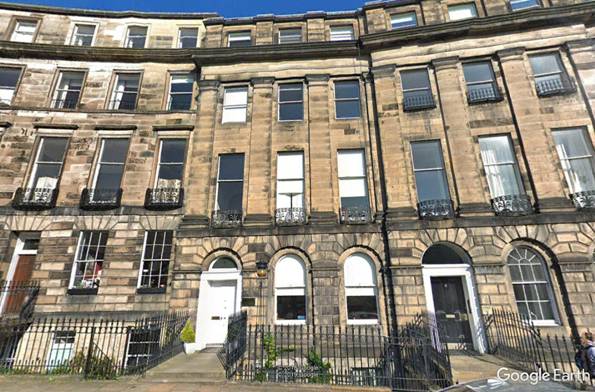
Figure 26. Residences on
Ainslie Place, Edinburgh, c. 2019.
(Image courtesy of Google Earth)
While working for the General Post Office, Hopkyns continued to be carried on the rolls of the Reserve of Officers of the Army. The London Gazette of 3 August 1923 lists D.K. Hopkins [sic] to be Major, late Royal Engineers Special Reserve with the rank effect on the 7th of May 1923. He again appears in the London Gazette[xxxi] with an entry under Supplementary Reserve of Officers – Royal Engineers Postal Section. He is listed as Major D.K. Hopkyns from the Regular Reserve of Officers to be Major effective the 3rd of July 1926. The 1932 Annual Army Lists shows him as being a Major, Royal Engineers, Territorial Army and Supplementary Reserve. On the 22nd of September 1933 he ceased to belong to the Reserve of Officers after having “attained the age of removal”; that is, becoming too old to serve any further.
In 1935 Hopkyns was appointed the Head Postmaster of Plymouth and while serving in this position he was awarded the 1935 Jubilee Medal commemorate the twenty-fifth year of the reign of King George V.[xxxii] Major and Mrs. Hopkyns were still in Plymouth in 1938. On the 20th of July of that year they hosted up to 50 members of the British Medical Society for the 106th Annual meeting of the society held at Plymouth. They invited members of the society on an excursion by private cars to Holne, Hexworthy and Dartmeet, three historic towns in Devonshire and then provided tea for the group at Badger’s Holt, a restaurant nestled in the heart of Dartmoor on the banks on the river Dart.[xxxiii]
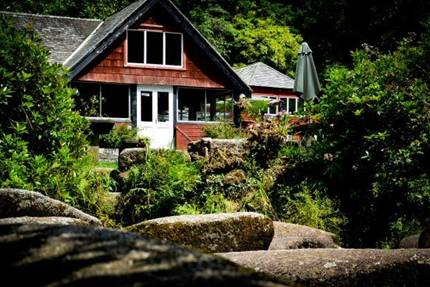
Figure 27. Badger’s Holt.
(Image courtesy of tripadvisor)
During World War 2 Hopkyns was awarded an Emergency Commission (Army Number EC 5039) as a Lieutenant (date not determined). This information was obtained from the London Gazette of 18 July 1947 in which his name had again been misspelled as Hopkins. This commission took him on, not with his previous Reserve of Officers rank, but as a Lieutenant. He relinquished his Emergency Commission on the 18th of July 1946 and was granted the rank of Honorary Captain.[xxxiv]
Daniel Knox Hopkyns died on the 11th of February 1963. His address at the time was 5 Bainbridge Avenue, Hartley, Plymouth. His will was probated on the 2nd of April 1963 at Exeter with his effects going to The Midland Bank Executor and Trust Company Limited and to his widow, Marjorie Verralls Bennett Hopkyns. His estate was valued at £51,089 (about $1,437,900 US in 2019 currency). His will included a bequest to Pembroke College for securities in the amount of £18,000. The Pembroke Record of 1968 states that:
“According to the will of the late Lt. Colonel D.K. Hopkyns (1902) the College is to receive securities to the value of about £18,000 to be used unconditionally for its benefit and advantage.”
Where the college got his military rank of Lieutenant Colonel could not be determined during this research.
As early as 1920 Hopkyns had been donating money to Pembroke College when he gave an undisclosed amount to the Pembroke College War Memorial Fund.
Marjorie Hopkyns died on the 4th of November 1967 while she was still living at the 5 Bainbridge Avenue address. Her will was probated at Bodmin with her effects going to The Midland Bank Executor and Trustee Company Limited in the amount of £31,085 (about $758,375 US in 2019 currency).[xxxv]
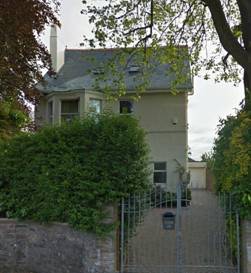
Figure 28. The Hopkyns
Residence at 5 Bainbridge Avenue, Hartley, Plymouth.
(Image courtesy of Google Earth)
REFERENCES:
Army Lists
Books
Census
Correspondence
FIREBRACE, J.A. Andover, Hampshire. Letter
dated 22 December 1987, re: Major
D.K. Hopkyns.
Documents
Family Trees
http://gibbsfamilytree.com/tng/familygroup.php?familyID=F1380&tree=gft1
Internet Web Sites
https://www.thegazette.co.uk/awards-and-accreditation/ww1
https://www.reubique.com/47668.htm
https://www.iwm.org.uk/memorials/name/135963
http://www.dreadnoughtproject.org/tfs/index.php/H.M.S._Ossory_(1915)
https://en.wikipedia.org/wiki/HMS_Erin
http://pcsbranch.org.uk/history-of-postal-courier-service/
https://www.findagrave.com/memorial/12327715/thomas-gray-hopkyns
https://www.masonicgreatwarproject.org.uk/legend.php?id=3546
http://findit.library.yale.edu/bookreader/BookReaderDemo/index.html?oid=11173004#page/5/mode/1up
11.
Pounds
Sterling to Dollars: Historical Conversion of Currency, by Eric Nye, Department
of English, University of Wyoming
https://www.uwyo.edu/numimage/currency.htm
www.nla.gov.au>files>blogs>m_407-409_etc_t_g_s_ward
https://en.wikipedia.org/wiki/Battle_of_the_Menin_Road_Ridge
London and Edinburgh Gazettes
Edinburgh Gazette, 6 December 1907, p.1333.
London Gazette, 3 December 1914, p. 10282.
London Gazette, 8 December 1914, p. 10454.
London Gazette, 5 May 1915, p. 4374.
London Gazette, 10 July 1915, p. 6807.
London Gazette, 12 August 1915, p. 8000.
London Gazette, 14 December 1917, pp. 13067 and 13083.
London Gazette, 16 January 1918, p. 919.
London Gazette, 5 March 1918, p. 2766.
London Gazette, 15 April 1918, p. 4510.
Supplement to the London Gazette, 8 January 1919, p. 461.
London Gazette, 2 August 1919, p. 9949.
London Gazette, 3 August 1923, p. 5342.
London Gazette, 21 August 1923, p. 5703.
London Gazette, 2 July 1926.
London Gazette, 1 June 1928, p. 3850.
London Gazette, 20 October 1933, p. 6761.
London Gazette, 18 July 1947, p. 3374.
London Gazette, 24 July 1970, p. 8294.
Medal Rolls
Royal Engineers Medal Roll, 1914-15 Star, Officers, Army Order 20 of 23 December 1918.
Royal Engineers Medal Roll, British War Medal and Victory Medal, Officers, OFF/144.
Naval Medal Roll, 1914-15 Star, British War Medal and Victory Medal, p. 137.
Periodicals
Oxford University Gazette, 27 December 1901, p. 245.
Oxford University Gazette, 4 November 1902, p. 110.
Supplement to the British Medical Journal, London, 9 July 1938, p. 26.
City of London Yearbook, 1915.
Crockford Clerical Directory, 1898
The Reading Mercury, 6 October 1917.
Record of Old Westminsters, 1927, p. 477.
Registers
1.
England & Wales, Civil Registration Birth Index, 1837-1915, Birth, Baptism
& Christening. Record information: Daniel Knox
Hopkyns, Oct 1883 Chichester, Sussex.
2. British Postal Service Appointment Book, 1907.
3. Edinburgh, Scotland Electoral Registers: 1920, 1921 and 1925.
4. London City Directories, 1915-1920
5. 1939 England and Wales Register
6. England & Wales, Civil Registration Death Index, 1916-2007, Death, Burial, Cemetery & Obituaries, Record information: Daniel K Hopkyns, Jan 1963 Plymouth, Devon, England.
7. United Kingdom Clergy List, 1897.
8. London Electoral Registers, 1832-1965.
9. Supplement to the Westminster School Register, October 1883 to October 1893, p. 12.
10. Probate Calendar, 1931, p. 290.
11. Probate Calendar, 1932, p. 289.
12. Probate Calendar, 1954, p. 589.
13. Probate Calendar, 1955, p. 596.
14. Probate Calendar, 1963, p. 787.
15. Probate Calendar, 1967, p. 601.
16. Probate Calendar, 1969, p. 489.
17. Probate Calendar, 1970, p. 506.
18. Registers of Employees of the East India Company and the India Office, 1746-1939.
19. UK, City and County Directories, 1766 – 1946.
20. Register of Alumni of Keble College, 1870-1925, p. 330.
[i] This problem also plagued the author of this work on Hopkyns life and service as it took numerous searches of the London Gazette by both names in order to uncover required information.
[ii] Merchant Taylor’s School Register.
[iii] An exhibition is a financial award or grant to an individual student, normally on grounds of merit (at Oxford and Cambridge, for example, it is typical to be awarded an exhibition for first-class performance in examinations). The amount is less than a scholarship.
[iv] Oxford University Gazette.
[v] Wells Theological College began operation in 1840 within the Cathedral Close of Wells Cathedral. It was one of several new colleges created in the nineteenth century to cater not just for non-graduates, but for graduates from the old universities who wished to receive specialist clerical training in preparation for ordination into the Church of England. It was founded by Bishop Law.
[vi] His name appears in the 1907 Postal Appointment Book with Number of Registration 538345.
[vii] Merchant Taylor’s School Register.
[viii] These are the War Office file numbers where officers’ records may be found.
[ix] Army List, February 1915.
[x] London Gazette, 5 May 1915.
[xi] His appointment as Assistant Director of Postal Service was almost immediately cancelled, as announced in the London Gazette dated 12 August 1915.
[xii] Medal Index Card and Great War Forum.
[xiii] British Army Post Offices During the Great War web site.
[xiv] London Gazette, 16 January 1918.
[xv] British Army Post Offices During the Great War web site
[xvi] London Gazette, 5 March 1918 and 15 April 1918.
[xvii] Craig indicates this in the Oxford University Roll of Service, although no verification has been found in the London Gazette.
[xviii] Craig and Army List, 1924.
[xix] London Gazette, 2 August 1919.
[xx] Medal Index Card.
[xxi] All of the items listed in the table are in the author's collection.
[xxii] As indicated in the table in Section 8, Hopkyns was entitled to the 1914-15 Star. This medal was missing from the group when the medals were purchased by the author.
[xxiii] Crockford Clerical Directory, 1898.
[xxiv] These references include clergy lists and the London Electoral Registers from 1832 to 1965.
[xxv] In each district the collector, who is also the district magistrate, is the principal representative of the administration. The collector functions in close cooperation with the superintendent of police to maintain law and order in the district and serves as the principal revenue officer.
[xxvi] A deputy collector, often abbreviated to DC, is a State Administrative Service officer in charge of revenue collection and administration of a sub-division in India.
[xxvii] Supplement to the London Gazette, 8 January 1919, p. 461.
[xxviii] UK Registers of Employees of the East India Company and the India Office, 1746-1939.
[xxix] This date probably should be 1905.
[xxx] Masonic Great War Project 2003.
[xxxi] London Gazette dated 2 July 1926.
[xxxii] Merchant Taylor’s School Register.
[xxxiii] British Medical Journal.
[xxxiv] London Gazette, 18 July 1947.
[xxxv] Probate Calendar, 1967, p. 601.